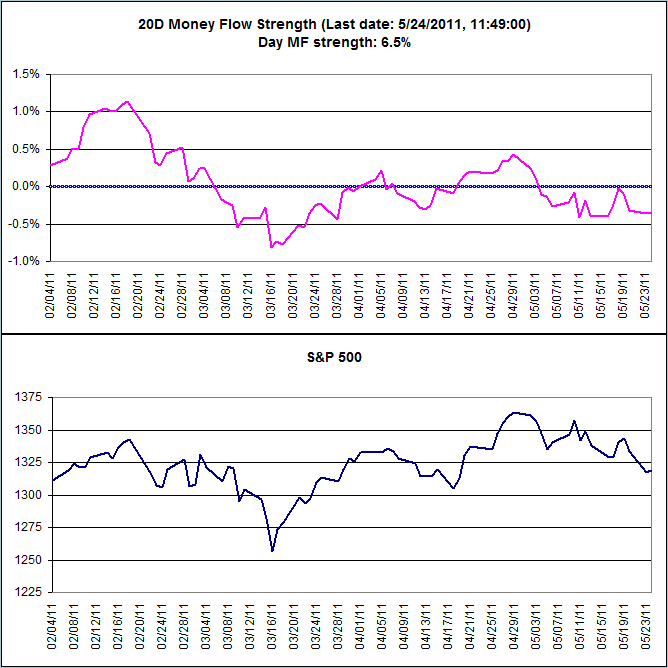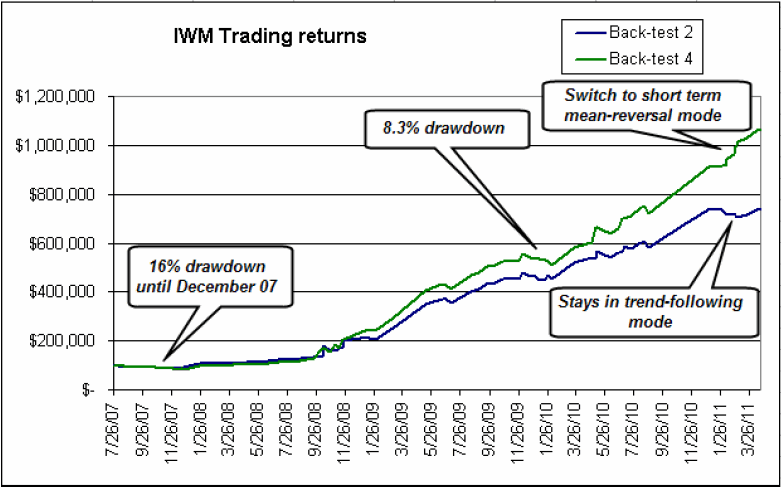Todays' bounce is lying dead in the water. this is not good, knowing that we have some POMO money washing things down (I mean "up").
Pascal

Todays' bounce is lying dead in the water. this is not good, knowing that we have some POMO money washing things down (I mean "up").
Pascal

Would It be possible to get an excel/csv posting of the historical 20dmf signals. For all users here ... finding a market directional model to help stay on the right side of the trade would obviously be incredibly beneficial, and I think the 20dmf would be a great tool for that, BUT ... I want to backtest some strategies to prove that.
The goal is that when 'my' system says to go long, I would only enter the trade if the 20dmf is bullish as well. many of us in this group currently do this, but having the past signals to test trading ideas and strategies would be incredibly beneficial for all involved. Since testing using historical data obviously is the only way to know if the strategy has the potential to be profitable and what the r/r ratios would be.
Bottom line ... it would be extremely useful!!
I think just the date and the signal type (buy, neutral, sell) is all that would be needed.
Thank you in advance!
Thank you for the update, Pascal.
You said in this thread that you would do 20DMF 'forum updates' in one thread.
Please do that, so that if we are not in the forum, we can get still alerted to any comments you may have by subscribing to the 20DMF thread.
Sure. no problem. here it is.
Pascal
20DMF_Trades.xls
Pascal
Can you explain why there is a difference between your recent post of 20DMF Signals vs. what was once available (at least I cannot find it) on the forum website (http://www.effectivevolume.com/_ss.p...ots_Method.pdf). i have attached a Mac Excel .xls spreadsheet of the original signals.
Thanks
Dave
Good find Dave! and Good question!
This is a pretty good question indeed!
There was an evolution between December and now: the IWM robot has been developed.
How did this affect the 20DMF method? In two ways:
1. When I developed the IWM robot and looked at the statistics, I noted that when the OB/OS indicator was extremely negative (below -90), we always experienced a reversal in the next days. This basically meant that pressing on a short in such conditions was not a good idea. I thus inserted that specific condition on the 20DMF: cover shorts when OB/OS reaches -90.
2. I then had a long thought about the "porosity" parameter that was set in the 20DMF. This parameter's intention is to avoid whipsaws when the indicator barely crosses a certain level and then reverses back. The porosity parameter says that the level must be crossed by a certain arbitrary level. The porosity parameter has a noble element though: it avoids the whipsaws effect in ill-timed trading decisions. This is positive when the 20DMF is used as a stand alone indicator. However, when it is used as an element of another indicator (such as the Robot), then the porosity parameter has a negative effect: it masks or delays to communicate the information that we have crosses some level. Since the 20DMF is handing the trade decision to the robot, I decided to limit the porosity parameter as much as possible and let the robot use the 20DMF together with his other indicators - and the associated statistic tables and the floor levels - to take trading decisions that were closer to the market.
The consequence is that indeed, the 20DMF as part of the robot produces more trades than the 20DMF when it was stand alone, and also produces lower returns (As a reference, the stand alone 20DMF generated 30 trades until Dec 15, 2001, for a total SPY return of 316%, while the actual 20DMF generated 36 trades during the same period, for a return of 291% as of January 28, 2011.
However, you can see below (first figure) the IWM returns using the multi time frame pivots and the stand alone 20DMF, compared to the Robot IWM return (second figure). The difference is very obvious.
Pascal

Pascal
Thanks for your in-depth explanation. So you have two systems: the original 20DMA and the new IWM Robot.
I will forward you tomorrow some Excel calculations I did for the two system signals on various ETFs.
Dave
Pascal
Here is a Mac Word 2004 document that describes my calculations in detail.
Executive summary: The 20DMF shows about a 10% higher CAGR than the IWM Robot over the 7/24/2007 to 12/2/2010 time period.
I have also attached two spreadsheets that show the actual calculations and charts of the two systems. I hope you can open and read them.
Executive summary: The two charts are worth 2000 words.
Dave